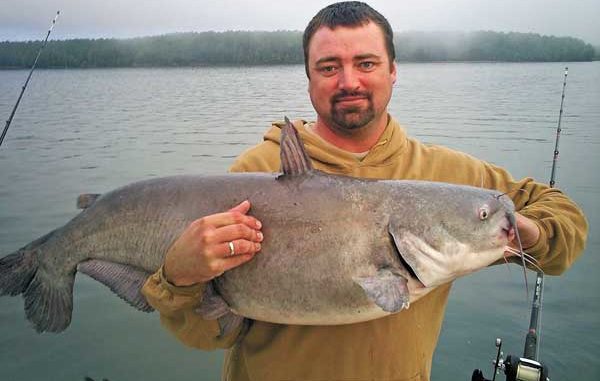
Lake Monticello is developing into a blue-ribbon fishery for blue catfish.
Catfish love ledges; the reason is not entirely clear. All sorts of fish relate to what offshore saltwater captains like to call “bottom relief” — really just a break in a continuous flat bottom. Take a look at a map of Lake Monticello, and you get an immediate understanding of why catfish love this lake. Its floor is comprised of a vast array of ditches, ridges, humps, lumps and other prime catfish-holding areas.
In addition to the favorable topography, Monticello has its own built-in fish sanctuary. Because the lake is the main storage facility for cooling water to supply SCE&G’s VC Summer Nuclear Facility, there is an approximate 1-mile exclusion zone where neither boats nor people are allowed. This zone provides several hundreds of acres of water for blue catfish to grow to tremendous size and supply the entire lake with trophy fish.
After winning several tournaments on the Carolina Catmen and Cabela’s King Kat tours, Chris Simpson of Ninety Six decided to hang out his shingle as a catfish guide, specializing in showing anglers how to fish Monticello’s water for trophy cats.
“There’s a big difference between what it takes to catch a mess of small, eating-size catfish and what you do to get a double-armful blue catfish on this lake,” said Simpson, whose business is called Fightin’ Da Blues Guide Service. “The lake is full of both big and little cats, and which one you get depends on how you fish.”
For Simpson, there is no hurry involved in getting a trophy blue cat to bite. If he’s on a spot he knows has the potential to produce a good fish, he’s willing to wait two or three hours for a big blue to get in the mood before he’ll vacate a spot.
“In April, the blues won’t begin the spawn here ’til later this month, and it usually winds up being May before they really get to it,” he said. “So right now, we’re going to anchor down around humps and ledges and use some tempting, hand-sized chunks of cut bait to get their attention.”
Lake Monticello differs a great deal from most other South Carolina lakes — it was impounded on a relatively small creek but does not rely on that creek for much of its water flow. Monticello was impounded on Frees Creek, which runs parallel to the larger Broad River. The majority of water flow into Monticello is from water pumped out of the Broad River as part of the operation of the nuclear plant, and then pumped back out of Monticello into the Broad.
“Fish don’t move upriver here like they do on other lakes,” Simpson said. “The pumping station creates all the current. Generating water can have a big effect on the fishing. In the spring, they’re usually pulling water all night ’til sometime about midmorning, then they’ll pump it back out. The fishing is typically better on the incoming generation than the outgoing.”
Simpson said underwater humps and islands are all over the lake’s floor. Completed in 1979, Monticello is relatively “young,” and the standing timber that was left is still pretty green — and collects a lot of fishing tackle for those who fish too close to it.
During the prespawn, Simpson said the presence of baitfish is not as important as it is at other times of the year. He starts catching big males when they start getting territorial around the best humps and ledges.
“One way to tell they are getting ready for the spawn is that we’ll start catching these males with what looks to be swollen glands on the tops of their heads, and they’ll come to the boat all scratched up like they’ve been fighting,” he said. “It looks like they’ve been drug down a gravel road.
“We even get big fish that will top 40 pounds, and they’ll have a bite mark on them from a fish that looks like it got its mouth most of the way around that 40-pounder,” he said. “One that can whip a 40-pounder’s tail like that is a fish I’d like to get a hook into.”
Scott Lamprecht, a fisheries biologist with the S.C. Department of Natural Resources, shed some light on this behavior, which becomes increasingly prevalent as catfish move toward the spawn in May.
“Mature males will battle for prime spawning locations,” Lamprecht said. “This activity can be related to male deer, which become increasingly aggressive toward other males as breeding season arrives.”
Lamprecht said that blue cats are ideally “cavity spawners.” They seek out locations they can back into and guard their nests from egg predators. With large numbers of catfish in Monticello, spawning sites are at a premium, but catfish often can make due with other arrangements.
“You typically think about catfish spawning in holes, but acceptable deviations from this might include a protected area around stumps, rock outcroppings, or ledges, especially a ledge where current has undercut the bank,” Lamprecht said. “Considering Monticello’s terrain as pretty much a system of valleys and ridges, and with all the current that’s pumped in and out of the lake, it would make sense that the undercut side of a ledge or hump would make for prime nesting sites.”
Tackle choices for Monticello cats cover the spectrum from ultra-light to heavy. The distinguishing factor is which size catfish you’re targeting — they also cover the spectrum from ultra-light to heavyweights.
Simpson’s gear choices tend to be on the larger side. He favors Shakespeare’s 7- and 8-foot medium-heavy action catfish rods, which he pairs with high-capacity baitcasting reels spooled with 30-pound Berkley Big Game line.
“A Carolina catfish rig is pretty standard for this kind of fishing,” Simpson said. “I thread a 3-ounce egg sinker on the main line, add a barrel swivel, then tie on a 2- to 3-foot section of 50-pound test Cajun Red mono leader. My hooks are 8/0 Gamakatsu Circle C hooks. I try to match the hook size with the size bait I’m using.”
Simpson likes to “match the hatch” by using cut pieces from native fish. His preferred bait is cut from gizzard shad, bream or white perch that catches a day or two before he heads out. He keeps the bait whole in Ziplock bags to be cut during the trip. Typically, catfish won’t be finicky about eating natural cut baits. This also has a bearing on how he sets the hook.
“We’ll see the rod tip wiggle or even bend slightly,” he said. “That’s just a small cat chewing on the bait, which often will attract the attention of a larger cat. I like to wait ’til the rod is bent double and ripping drag before I take the rod out of the holder. The trophy cats usually hook themselves with the circle hooks anyway.”

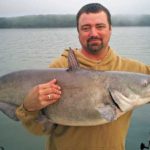
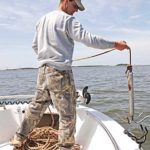
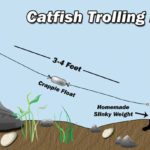
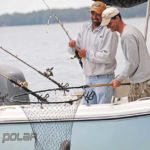

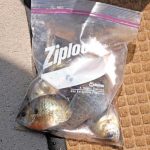



Be the first to comment